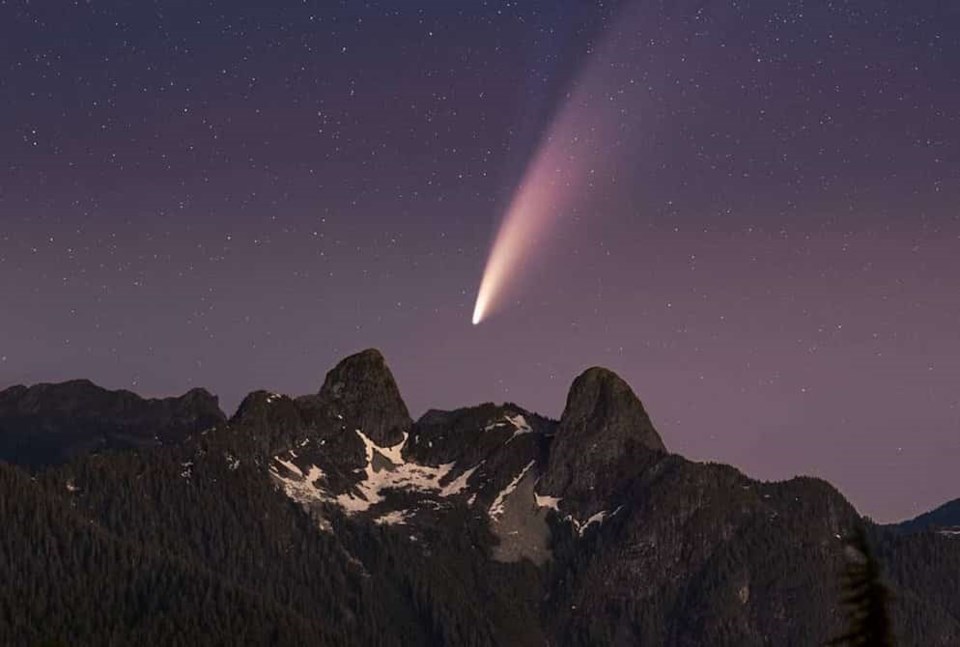British Columbians are sharing images of a recently discovered comet that will be visible over B.C. for the next couple of weeks, before disappearing again for thousands of years.
The Neowise comet, discovered in March by NASA’s Neowise infrared space telescope, reached its closest point to the sun on July 3, which caused the “frozen ice ball” to heat up and burn gas and dust off its surface.
NASA explains that, "This very close passage by the Sun is cooking the comet's outermost layers, causing gas and dust to erupt off the icy surface and creating a large tail of debris. And yet the comet has managed to survive this intense roasting."
What's more, the astronauts aboard the International Space Station spotted it from their vantage point high above Earth's atmosphere.
"From its infrared signature, we can tell that it is about 5 kilometers [3 miles] across, and by combining the infrared data with visible-light images, we can tell that the comet's nucleus is covered with sooty, dark particles left over from its formation near the birth of our solar system 4.6 billion years ago," said Joseph Masiero, NEOWISE deputy principal investigator at NASA's Jet Propulsion Laboratory in Southern California.
The comet will be visible for a few weeks, and it can be seen with the naked eye. However, binoculars will make for better visuals.
Have a look at some of the best photos from the Lower Mainland over the past few days.
Comet NEOWISE photographed over Vancouver this morning.
— Claude Schneider (@claudeschneider) July 11, 2020
The best time to see it is around 3am - that will be getting earlier each night, although the comet will be getting fainter as it travels out into the solar system.#comet #cometNEOWISE #NEOWISE #vancouver @c2020f3 pic.twitter.com/xug7BHgMSW
Even better photos of Comet NEOWISE photographed over Vancouver on Sunday night.
— Claude Schneider (@claudeschneider) July 13, 2020
The clearer skies meant the comet's tail was visible to the naked eye, and photos reveal the comet's second, fainter ion tail.#comet #cometNEOWISE #NEOWISE #vancouver @c2020f3 @DailyHiveVan @CTV pic.twitter.com/3u5apFNXNS
Comet C/2020 F3 Neowise over Vancouver! We took this image around 11pm last night, but I first spotted it at 10:15pm. Image credit: Jordash Kiffiak and Joanna Woo pic.twitter.com/d9q5q8ZsXD
— Joanna Woo (@JoannaAstro) July 13, 2020
Woohoo! Managed to find and photograph comet #NEOWISE from Vancouver pic.twitter.com/TgUtjJGBW7
— Andy Gibb (@_andy_gibb_) July 13, 2020
Four shots of #Comet #NEOWISE over #Vancouver tonight. Mostly 10 s exposures around ISO 1000 at f4.5. Yes, naked-eye visible in city lights. The time exposures bring out detail the eye doesn't see. @phi48 @ian_doktor @OrcaBC101 @bc_news_addict @MMadryga @jennifer_kirkey pic.twitter.com/iwa6QPJ13V
— Peter Vogel (@PeterVogel) July 14, 2020
Comet Neowise setting over Vancouver pic.twitter.com/hrftuFltxI
— Tyler Black, MD (@tylerblack32) July 14, 2020
#cometNEOWISE from Spanish Banks in Vancouver B.C. after sunset on July 13, 2020. Easy through binoculars but faint visually. Shots taken just before 11 pm PDT.#comet #YVRwx #NEOWISE pic.twitter.com/3Tiz8UyYQY
— Michel Gélinas (@GarconGlacon) July 14, 2020
Comet watching over West Vancouver. #comet #neowise #neowisec2020f3 #vancouver pic.twitter.com/yk0ULJebmc
— Mark Atomos Pilon (@Atomos) July 14, 2020
Watch a short video from the H.R. MacMillan Space Centre about how to find the comet.
With files from The Associated Press and Roxanne Egan-Elliott.



